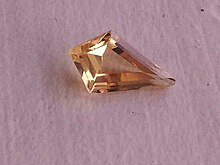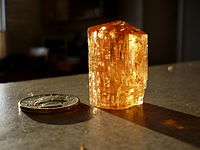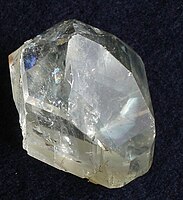Topaz
From Wikipedia, the free encyclopedia
| Topaz | |
|---|---|

| |
| General | |
| Category | Silicate mineral |
| Formula (repeating unit) | Al2SiO4(F,OH)2 |
| Strunz classification | 9.AF.35 |
| Crystal symmetry | Orthorhombic dipyramidal H-M symbol: (2/m 2/m 2/m) Space group: Pbnm |
| Unit cell | a = 4.65 Å, b = 8.8 Å, c = 8.4 Å; Z = 4 |
| Identification | |
| Color | Colorless (if no impurities), blue, brown, orange, gray, yellow, green, pink and reddish pink |
| Crystal habit | Prismatic crystals with faces striated parallel to long dimension; also columnar, compact, massive |
| Crystal system | Orthorhombic |
| Cleavage | [001] Perfect |
| Fracture | Subconchoidal to uneven |
| Mohs scalehardness | 8 (defining mineral) |
| Luster | Vitreous |
| Streak | White |
| Diaphaneity | Transparent |
| Specific gravity | 3.49–3.57 |
| Optical properties | Biaxial (+) |
| Refractive index | nα = 1.606–1.629 nβ = 1.609–1.631 nγ = 1.616–1.638 |
| Birefringence | δ = 0.010 |
| Pleochroism | Weak in thick sections X = yellow; Y = yellow, violet, reddish; Z = violet, bluish, yellow, pink |
| Ultravioletfluorescence | Short UV=golden yellow; Long UV=cream |
| References | [1][2][3][4] |
Topaz is a silicate mineral of aluminium and fluorine with the chemical formula Al2SiO4(F,OH)2. Topaz crystallizes in theorthorhombic system, and its crystals are mostly prismatic terminated by pyramidal and other faces.
Color and varieties[edit]
Pure topaz is colorless and transparent but is usually tinted by impurities; typical topaz is wine red, yellow, pale gray, reddish-orange, or blue brown. It can also be white, pale green, blue, gold, pink (rare), reddish-yellow or opaque to transparent/translucent.
Orange topaz, also known as precious topaz, is the traditional November birthstone, the symbol of friendship, and the state gemstone of the US state of Utah.[5]
Imperial topaz is yellow, pink (rare, if natural) or pink-orange. Brazilian Imperial Topaz can often have a bright yellow to deep golden brown hue, sometimes even violet. Many brown or pale topazes are treated to make them bright yellow, gold, pink or violet colored. Some imperial topaz stones can fade on exposure to sunlight for an extended period of time.[6][7]
Blue topaz is the state gemstone of the US state of Texas.[8] Naturally occurring blue topaz is quite rare. Typically, colorless, gray or pale yellow and blue material is heat treated andirradiated to produce a more desired darker blue.[7]
Mystic topaz is colorless topaz which has been artificially coated giving it the desired rainbow effect.[9]
Localities and occurrence[edit]
Topaz is commonly associated with silicic igneous rocks of the granite and rhyolite type. It typically crystallizes in granitic pegmatites or in vapor cavities in rhyolite lava flows including those at Topaz Mountain in western Utah and Chivinar in South America. It can be found withfluorite and cassiterite in various areas including the Ural and Ilmen mountains of Russia, in Afghanistan, Sri Lanka, Czech Republic,Germany, Norway, Pakistan, Italy, Sweden, Japan, Brazil, Mexico; Flinders Island, Australia; Nigeria and the United States.
Some clear topaz crystals from Brazilian pegmatites can reach boulder size and weigh hundreds of pounds. Crystals of this size may be seen in museum collections. The Topaz of Aurangzeb, observed by Jean Baptiste Tavernier weighed 157.75 carats.[10] TheAmerican Golden Topaz, a more recent gem, weighed a massive 22,892.5 carats.
Colorless and light-blue varieties of topaz are found in Precambrian granite in Mason County, Texas[11] within the Llano Uplift. There is no commercial mining of topaz in that area.[12]
Etymology[edit]
The name "topaz" is usually derived (via Old French: Topace and Latin: Topazus) from the Greek Τοπάζιος (Τοpáziοs) or Τοπάζιον(Τοpáziοn),[13] from Τοπαζος, the ancient name of St. John's Island in the Red Sea which was difficult to find and from which a yellow stone (now believed to be chrysolite: yellowish olivine) was mined in ancient times; topaz itself (rather than topazios) was not really known before the classical era. Pliny said that Topazos is a legendary island in the Red Sea and the mineral "topaz" was first mined there. Alternatively, the word topaz may be related to the Sanskrit word तपस् "tapas", meaning "heat" or "fire".[13]
Historical usage[edit]
Nicols, the author of one of the first systematic treatises on minerals and gemstones, dedicated two chapters to the topic in 1652.[14] In the Middle Ages, the name topaz was used to refer to any yellow gemstone, but in modern times it denotes only the silicate described above.
Many modern English translations of the Bible, including the King James Version mention topaz. However, because these translations as topaz all derive from the Septuaginttranslation topazi[os], which as mentioned above referred to a yellow stone that was not topaz, but probably chrysolite (chrysoberyl or peridot), it should be borne in mind that topaz is likely not meant here.[15] The masoretic text (the Hebrew on which most modern Protestant Bible translations of the Old Testament are based) has pitdah as the gem the stone is made from; some scholars think it is related to an Assyrian word meaning "flashed".[citation needed] More likely, "pitdah" is derived from Sanskrit words (पीत pit = yellow, दह्dah = burn), meaning "yellow burn" or, metaphorically, "fiery"









Nenhum comentário:
Postar um comentário